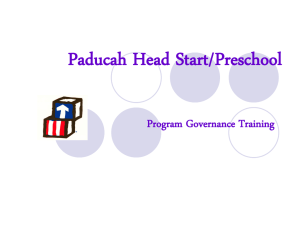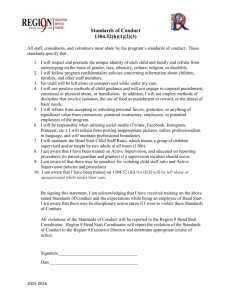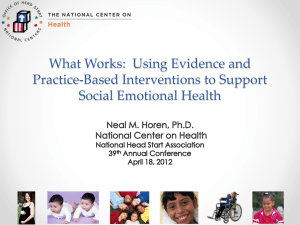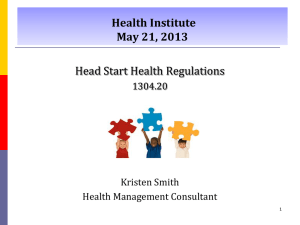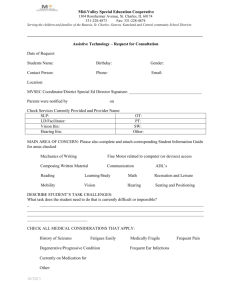Safe Environments Observation Form
advertisement
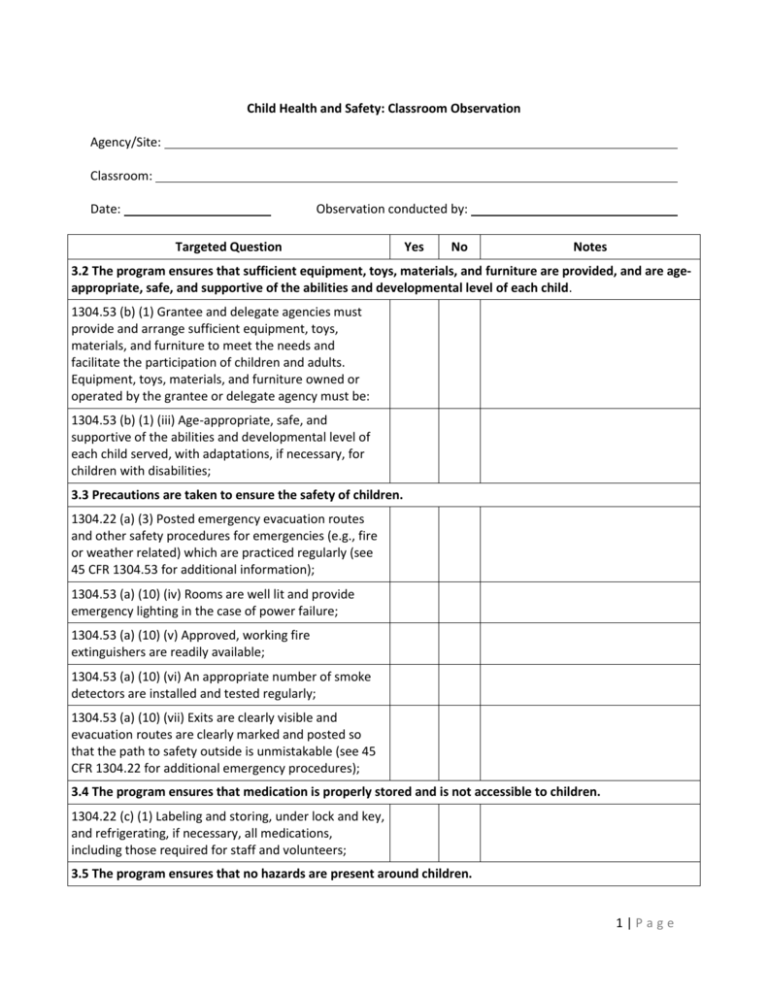
Child Health and Safety: Classroom Observation Agency/Site: Classroom: Date: Observation conducted by: Targeted Question Yes No Notes 3.2 The program ensures that sufficient equipment, toys, materials, and furniture are provided, and are ageappropriate, safe, and supportive of the abilities and developmental level of each child. 1304.53 (b) (1) Grantee and delegate agencies must provide and arrange sufficient equipment, toys, materials, and furniture to meet the needs and facilitate the participation of children and adults. Equipment, toys, materials, and furniture owned or operated by the grantee or delegate agency must be: 1304.53 (b) (1) (iii) Age-appropriate, safe, and supportive of the abilities and developmental level of each child served, with adaptations, if necessary, for children with disabilities; 3.3 Precautions are taken to ensure the safety of children. 1304.22 (a) (3) Posted emergency evacuation routes and other safety procedures for emergencies (e.g., fire or weather related) which are practiced regularly (see 45 CFR 1304.53 for additional information); 1304.53 (a) (10) (iv) Rooms are well lit and provide emergency lighting in the case of power failure; 1304.53 (a) (10) (v) Approved, working fire extinguishers are readily available; 1304.53 (a) (10) (vi) An appropriate number of smoke detectors are installed and tested regularly; 1304.53 (a) (10) (vii) Exits are clearly visible and evacuation routes are clearly marked and posted so that the path to safety outside is unmistakable (see 45 CFR 1304.22 for additional emergency procedures); 3.4 The program ensures that medication is properly stored and is not accessible to children. 1304.22 (c) (1) Labeling and storing, under lock and key, and refrigerating, if necessary, all medications, including those required for staff and volunteers; 3.5 The program ensures that no hazards are present around children. 1|Page Targeted Question Yes No Notes 1304.53 (a) (8) Grantee and delegate agencies must provide a center-based environment free of toxins, such as cigarette smoke, lead, pesticides, herbicides, and other air pollutants as well as soil and water contaminants. Agencies must ensure that no child is present during the spraying of pesticides or herbicides. Children must not return to the affected area until it is safe to do so. 1304.53 (a) (10) (i) In climates where such systems are necessary, there is a safe and effective heating and cooling system that is insulated to protect children and staff from potential burns; 1304.53 (a) (10) (x) The selection, layout, and maintenance of playground equipment and surfaces minimize the possibility of injury to children; 1304.53 (a) (10) (xi) Electrical outlets accessible to children prevent shock through the use of child-resistant covers, the installation of child- protection outlets, or the use of safety plugs; 1304.53 (a) (10) (xii) Windows and glass doors are constructed, adapted, or adjusted to prevent injury to children; 1304.53 (a) (10) (xiv) Toilets and handwashing facilities are adequate, clean, in good repair, and easily reached by children. Toileting and diapering areas must be separated from areas used for cooking, eating, or children's activities; 1304.53 (a) (10) (xvi) All sewage and liquid waste is disposed of through a locally approved sewer system, and garbage and trash are stored in a safe and sanitary manner; and 3.6 The program ensures that sleeping arrangements for infants do not use soft bedding materials. Note: Applies only to programs serving infants and toddlers 1304.53 (b) (3) To reduce the risk of Sudden Infant Death Syndrome (SIDS), all sleeping arrangements for infants must use firm mattresses and avoid soft bedding materials such as comforters, pillows, fluffy blankets or stuffed toys. 3.7 All infant and toddler toys are made of non-toxic materials and sanitized regularly. Note: Applies only to programs serving infants and toddlers 1304.53 (b) (2) Infant and toddler toys must be made of non-toxic materials and must be sanitized regularly. 2|Page Targeted Question Yes No Notes 3.8 The program has adequate usable indoor and outdoor space. 1304.53 (a) (5) Centers must have at least 35 square feet of usable indoor space per child available for the care and use of children (i.e., exclusive of bathrooms, halls, kitchen, staff rooms, and storage places) and at least 75 square feet of usable outdoor play space per child. 3.9 Outdoor play areas at center-based programs are arranged to prevent children from getting into unsafe and/or unsupervised areas. The program also ensures that children en route to play areas are not exposed to vehicular traffic without supervision. Note: Applies only to programs with a center-based program option 1304.53 (a) (9) Outdoor play areas at center-based programs must be arranged so as to prevent any child from leaving the premises and getting into unsafe and unsupervised areas. Enroute to play areas, children must not be exposed to vehicular traffic without supervision. 3.10 The program ensures that facilities, materials, and equipment are well maintained, clean, and in good repair. 1304.53 (a) (7) Grantee and delegate agencies must provide for the maintenance, repair, safety, and security of all Early Head Start and Head Start facilities, materials and equipment. 1304.53 (a) (10) (viii) Indoor and outdoor premises are cleaned daily and kept free of undesirable and hazardous materials and conditions; 3.11 The program's facilities are adequate for children with disabilities, ensuring safety, comfort, and opportunities for participation. 1304.53 (a) (10) (xvii) Adequate provisions are made for children with disabilities to ensure their safety, comfort, and participation. 4.1 Staff, volunteers, and children wash their hands with soap and running water. 1304.22 (e) (1) Staff, volunteers, and children must wash their hands with soap and running water at least at the following times: (i) After diapering or toilet use; (ii) Before food preparation, handling, consumption, or any other food-related activity (e.g., setting the table); (iii) Whenever hands are contaminated with blood or other bodily fluids; and (iv) After handling pets or other animals. 4.2 Spilled bodily fluids are cleaned up and disinfected immediately according to professionally established 3|Page Targeted Question Yes No Notes guidelines. Tools and equipment used to clean spills are disinfected promptly, and blood- contaminated materials are disposed of in a plastic bag with a secure tie. 1304.22 (e) (3) Nonporous (e.g., latex) gloves must be worn by staff when they are in contact with spills of blood or other visibly bloody bodily fluids. 1304.22 (e) (4) Spills of bodily fluids (e.g., urine, feces, blood, saliva, nasal discharge, eye discharge or any fluid discharge) must be cleaned and disinfected immediately in keeping with professionally established guidelines (e.g., standards of the Occupational Safety Health Administration, U.S. Department of Labor). Any tools and equipment used to clean spills of bodily fluids must be cleaned and disinfected immediately. Other blood-contaminated materials must be disposed of in a plastic bag with a secure tie. 4.3 The program adopts sanitation and hygiene practices for diapering that adequately protect children’s and staff's health and safety. 1304.22 (e) (5) Grantee and delegate agencies must adopt sanitation and hygiene procedures for diapering that adequately protect the health and safety of children served by the program and staff. Grantee and delegate agencies must ensure that staff properly conduct these procedures. 4.7 The program ensures that facilities are available for proper refrigerated storage and handling of breast milk and formula. Note: Applies only to programs serving infants and toddlers 1304.23 (e) (2) For programs serving infants and toddlers, facilities must be available for the proper storage and handling of breast milk and formula. Additional comments: (Resource from The Ounce) 4|Page
